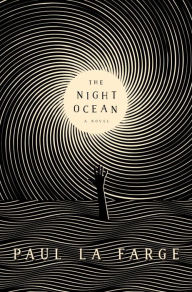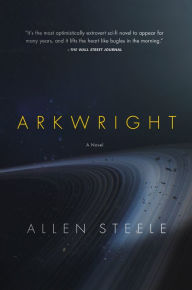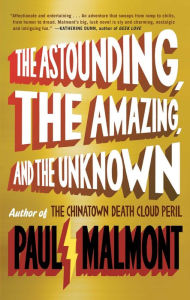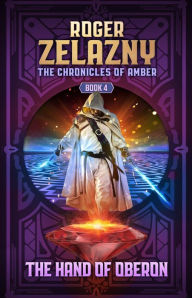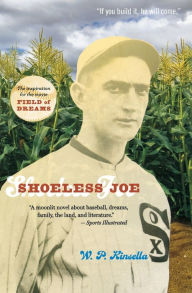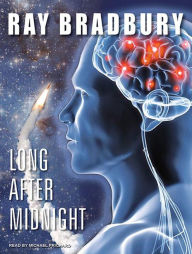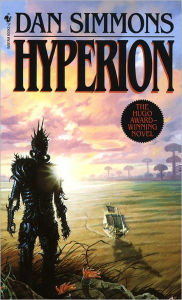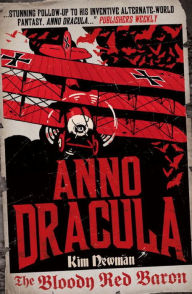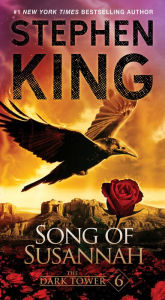10 Times Real Authors Appeared in Science Fiction & Fantasy Books
 No matter how creative a writer is, the characters they create will never be as interesting as some of the real people who have lived throughout history. Sometimes, this includes their fellow authors—whenever one writer inserts another into a narrative, even for just a cameo, things get interesting fast, and the meta-fictional hi-jinx pile up. In these 10 sic-fi and fantasy books, real authors show up and unexpectedly steal the show.
No matter how creative a writer is, the characters they create will never be as interesting as some of the real people who have lived throughout history. Sometimes, this includes their fellow authors—whenever one writer inserts another into a narrative, even for just a cameo, things get interesting fast, and the meta-fictional hi-jinx pile up. In these 10 sic-fi and fantasy books, real authors show up and unexpectedly steal the show.
The Night Ocean
The Night Ocean
Hardcover $27.00
Ursula K. LeGuin in The Night Ocean, by Paul La Farge
We’re in a golden age of Lovecraftian meta-fiction, and La Farge’s The Night Ocean is a standout entry in this evolving sub-genre. It tells the tangled story of a book called the Erotonomicon, supposedly written by Robert Barlow—Lovecraft’s much younger friend, rumored to have been much more—uncovered by journalist Charlie Willett. That Willett’s life is eventually destroyed by his discovery fits perfectly into the Lovecraftian themes, but one of the most surprising moments among many is when none other than Ursula K. LeGuin appears on the page; her brief cameo as the precocious 11-year old daughter of Barlow’s teacher, Alfred Kroeber, is illuminating and, above all, fun.
Ursula K. LeGuin in The Night Ocean, by Paul La Farge
We’re in a golden age of Lovecraftian meta-fiction, and La Farge’s The Night Ocean is a standout entry in this evolving sub-genre. It tells the tangled story of a book called the Erotonomicon, supposedly written by Robert Barlow—Lovecraft’s much younger friend, rumored to have been much more—uncovered by journalist Charlie Willett. That Willett’s life is eventually destroyed by his discovery fits perfectly into the Lovecraftian themes, but one of the most surprising moments among many is when none other than Ursula K. LeGuin appears on the page; her brief cameo as the precocious 11-year old daughter of Barlow’s teacher, Alfred Kroeber, is illuminating and, above all, fun.
Arkwright
Arkwright
By Allen Steele
Paperback
$17.09
$17.99
Heinlein, Clarke, and Asimov in Arkwright, by Allen Steele
Steele’s Arkwright is both a love letter to Golden Age sci-fi and a startlingly forward-looking story about one man’s impact on history. The instigating character, Nathan Arkwright, is presented as one of the ‛big four” sci-fi writers from that age, along with Robert Heinlein, Isaac Asimov, and Arthur C. Clarke—all of whom play a role in Arkwright’s evolution into a man obsessed with ensuring the survival of the human race. Steele manages to make you want to invent time travel so you too could have cocktails on an ocean liner with those three men.
Heinlein, Clarke, and Asimov in Arkwright, by Allen Steele
Steele’s Arkwright is both a love letter to Golden Age sci-fi and a startlingly forward-looking story about one man’s impact on history. The instigating character, Nathan Arkwright, is presented as one of the ‛big four” sci-fi writers from that age, along with Robert Heinlein, Isaac Asimov, and Arthur C. Clarke—all of whom play a role in Arkwright’s evolution into a man obsessed with ensuring the survival of the human race. Steele manages to make you want to invent time travel so you too could have cocktails on an ocean liner with those three men.
The Astounding, the Amazing, and the Unknown: A Novel
The Astounding, the Amazing, and the Unknown: A Novel
By Paul Malmont
Paperback
$17.83
$25.99
L. Ron Hubbard in The Astounding, the Amazing, and the Unknown, by Paul Malmont
It’s known but not widely remembered that Robert Heinlein, Isaac Asimov, and L. Sprague de Camp worked together for the Navy during World War II—but Malmont remembers, and uses it as a springboard for this rollicking historical adventure. Presented as a tale being told by Richard Feynman to his fellow Manhattan Project scientists, it eventually includes cameos by just about every sci-fi author of note from that era—including a hilarious depiction of L. Ron Hubbard, ultimately revealed to be the more or less unreliable originator of the whole tall tale.
L. Ron Hubbard in The Astounding, the Amazing, and the Unknown, by Paul Malmont
It’s known but not widely remembered that Robert Heinlein, Isaac Asimov, and L. Sprague de Camp worked together for the Navy during World War II—but Malmont remembers, and uses it as a springboard for this rollicking historical adventure. Presented as a tale being told by Richard Feynman to his fellow Manhattan Project scientists, it eventually includes cameos by just about every sci-fi author of note from that era—including a hilarious depiction of L. Ron Hubbard, ultimately revealed to be the more or less unreliable originator of the whole tall tale.
The Hand of Oberon
The Hand of Oberon
In Stock Online
eBook $5.99
Roger Zelazny in The Hand of Oberon, by Roger Zelazny
Zelazny’s Chronicles of Amber is a series lush with imagination, and it’s not too surprising that a real-life author makes a cameo in a no-holds barred universe where reality itself is a shadowy construct of someone’s imagination. It is a little surprising that the cameo is by Zelazny himself, encountered in a complex of prison cells, smoking a pipe and making cryptic remarks. It’s a delightful moment of self-awareness, and bends the brain a bit as Zelazny seems to describe the book he’s working on, which is pretty obviously the one you’re reading.
Roger Zelazny in The Hand of Oberon, by Roger Zelazny
Zelazny’s Chronicles of Amber is a series lush with imagination, and it’s not too surprising that a real-life author makes a cameo in a no-holds barred universe where reality itself is a shadowy construct of someone’s imagination. It is a little surprising that the cameo is by Zelazny himself, encountered in a complex of prison cells, smoking a pipe and making cryptic remarks. It’s a delightful moment of self-awareness, and bends the brain a bit as Zelazny seems to describe the book he’s working on, which is pretty obviously the one you’re reading.
Shoeless Joe
Shoeless Joe
By
W. P. Kinsella
Editor
John Radziewicz
In Stock Online
Paperback $17.99
J.D. Salinger in Shoeless Joe, by W.P. Kinsella
Kinsella’s elegiac novel about a magical cornfield where the ghosts of dead basely players pick up the game one last time was the source for the film Field of Dreams. Wait, you say, Salinger’s not in the movie—James Earl Jones plays a fictional writer? True, but only because Salinger threatened to sue if his likeness was used. In the novel, Salinger is the reclusive writer who winds up needing the help of Ray Kinsella to “ease his pain.”
J.D. Salinger in Shoeless Joe, by W.P. Kinsella
Kinsella’s elegiac novel about a magical cornfield where the ghosts of dead basely players pick up the game one last time was the source for the film Field of Dreams. Wait, you say, Salinger’s not in the movie—James Earl Jones plays a fictional writer? True, but only because Salinger threatened to sue if his likeness was used. In the novel, Salinger is the reclusive writer who winds up needing the help of Ray Kinsella to “ease his pain.”
Fantomas versus the Multinational Vampires: An Attainable Utopia
Fantomas versus the Multinational Vampires: An Attainable Utopia
By
Julio Cortázar
Translator
David Kurnick
Afterword
David Kurnick
Paperback $14.95
Susan Sontag in Fantomas versus the Multinational Vampires: An Attainable Utopia, by Julio Cortázar
Cortázar is a challenging author no matter the medium, but this graphic novel is quite the trip. Inspired by his disappointing involvement in the Second Russell Tribunal that investigated human rights abuses in South America, the story has cameos from a long list of writers who come together to battle evil corporate forces, including Susan Sontag and Cortázar himself—the author, the main character, and a character in a comic the author is reading.
Susan Sontag in Fantomas versus the Multinational Vampires: An Attainable Utopia, by Julio Cortázar
Cortázar is a challenging author no matter the medium, but this graphic novel is quite the trip. Inspired by his disappointing involvement in the Second Russell Tribunal that investigated human rights abuses in South America, the story has cameos from a long list of writers who come together to battle evil corporate forces, including Susan Sontag and Cortázar himself—the author, the main character, and a character in a comic the author is reading.
Long After Midnight
Long After Midnight
By
Ray Bradbury
Narrated by
Michael Prichard
Audiobook $83.99
George Bernard Shaw in Long After Midnight, by Ray Bradbury
Bradbury often used real authors as characters, but his short story “G.B.S.—Mark V” in the collection Long After Midnight is one of the best. It’s the tale of a crewmember on a spaceship who comes to prefer the company of a G.B.S. Android, which has Shaw’s personality—“dead but alive.” The best part is that the Shaw android is described as “unbearable,” yet charming, acknowledging that the people we find entertaining are not always 100 percent pleasant to be around, a demonstration of Bradbury’s incredible understanding of human nature.
George Bernard Shaw in Long After Midnight, by Ray Bradbury
Bradbury often used real authors as characters, but his short story “G.B.S.—Mark V” in the collection Long After Midnight is one of the best. It’s the tale of a crewmember on a spaceship who comes to prefer the company of a G.B.S. Android, which has Shaw’s personality—“dead but alive.” The best part is that the Shaw android is described as “unbearable,” yet charming, acknowledging that the people we find entertaining are not always 100 percent pleasant to be around, a demonstration of Bradbury’s incredible understanding of human nature.
Hyperion (Hyperion Series #1)
Hyperion (Hyperion Series #1)
By Dan Simmons
In Stock Online
Paperback $9.99
John Keats in Hyperion, by Dan Simmons
A bit of a cheat, as Simmons’ version of John Keats isn’t actually the author. A “cybrid” clone with a personality constructed from the surviving evidence of the real Keats is a key element in the fifth part of the first novel, “The Long Good-Bye.” The cybrid’s artificial intelligence was infected with a virus, and lost five days of memory before it could be restored from backup—providing the central mystery for this section of the book. Another Keats hybrid also essentially narrates the sequel, Fall of Hyperion.
John Keats in Hyperion, by Dan Simmons
A bit of a cheat, as Simmons’ version of John Keats isn’t actually the author. A “cybrid” clone with a personality constructed from the surviving evidence of the real Keats is a key element in the fifth part of the first novel, “The Long Good-Bye.” The cybrid’s artificial intelligence was infected with a virus, and lost five days of memory before it could be restored from backup—providing the central mystery for this section of the book. Another Keats hybrid also essentially narrates the sequel, Fall of Hyperion.
Anno Dracula: The Bloody Red Baron
Anno Dracula: The Bloody Red Baron
By Kim Newman
Paperback $14.95
Edgar Allan Poe in The Bloody Red Baron, by Kim Newman
Considering this sequel to Anno Dracula begins with half the world turned into vampires by Dracula himself, you might imagine no further literary trickery is needed—but Newman’s use of Edgar Allan Poe, hired to write an official biography of the vampiric Red Baron, who can change into a plane-sized bat for his aerial warfare, stands out as a truly fantastic idea.
Edgar Allan Poe in The Bloody Red Baron, by Kim Newman
Considering this sequel to Anno Dracula begins with half the world turned into vampires by Dracula himself, you might imagine no further literary trickery is needed—but Newman’s use of Edgar Allan Poe, hired to write an official biography of the vampiric Red Baron, who can change into a plane-sized bat for his aerial warfare, stands out as a truly fantastic idea.
Song of Susannah (The Dark Tower Series #6)
Song of Susannah (The Dark Tower Series #6)
By
Stephen King
Illustrator
Darrel Anderson
Paperback $9.99
Stephen King in The Dark Tower: Song of Susannah, by Stephen King
This one feels a bit too significant to call a mere cameo (it’s also a bit of a spoiler for the Dark Tower series, so beware), but we can’t end without mentioning that time Stephen King made himself the spoke upon which a whole universe of fiction revolves. In the sixth book of his metafictional magnum opus, gunslingers Roland Deschain and Eddie Dean travel from the post-apocalyptic Midworld to our world circa 1999 to treat with a certain famous novelist living out in Maine and literally hypnotize him to write the next books in the series (his real-life writer’s block is thus attributed to the influence of the despotic Crimson King). King’s presence is similarly felt in the subsequent, climactic book, The Dark Tower, in which the author writes the characters’ fates as they happen. Whoa.
BONUS ENTRY:
Stephen King in The Dark Tower: Song of Susannah, by Stephen King
This one feels a bit too significant to call a mere cameo (it’s also a bit of a spoiler for the Dark Tower series, so beware), but we can’t end without mentioning that time Stephen King made himself the spoke upon which a whole universe of fiction revolves. In the sixth book of his metafictional magnum opus, gunslingers Roland Deschain and Eddie Dean travel from the post-apocalyptic Midworld to our world circa 1999 to treat with a certain famous novelist living out in Maine and literally hypnotize him to write the next books in the series (his real-life writer’s block is thus attributed to the influence of the despotic Crimson King). King’s presence is similarly felt in the subsequent, climactic book, The Dark Tower, in which the author writes the characters’ fates as they happen. Whoa.
BONUS ENTRY:
Deep Secret
Deep Secret
Paperback $27.99
Neil Gaiman in Deep Secret (sort of), by Diana Wynne Jones
Not quite a cameo, but close enough to merit repetition of one of our favorite bits of trivia, is Neil Gaiman’s coded appearance in Diana Wynne Jones’ tremendously fun Deep Secret, in which an inter-dimensional rift opens at the site of popular science fiction convention, giving an already gaudy, unrestrained gathering a decidedly otherworldly air. One of the attendees, Nick Mallory, isn’t strictly Gaiman, but his nearly zombie-like nature in the mornings is modeled directly on the famously black-clad author (just check out this version of the cover art), whom Wynne Jones befriended during his earliest days as a genre fan, and later, when he was a superstar author in his own right. In fact, Gaiman points out that the scene in which Nick sleepily eats two breakfasts actually happened to him when he and Wynne Jones attended a writer’s conference. (As pointed out in the comments, Gaiman makes a proper appearance in Paul Cornell’s urban fantasy The Severed Streets, but Cornell himself said that it was “more than a mere cameo” so we’ll leave it to you to decide if it belongs on the list.)
What awesome literary cameos did we miss?
Neil Gaiman in Deep Secret (sort of), by Diana Wynne Jones
Not quite a cameo, but close enough to merit repetition of one of our favorite bits of trivia, is Neil Gaiman’s coded appearance in Diana Wynne Jones’ tremendously fun Deep Secret, in which an inter-dimensional rift opens at the site of popular science fiction convention, giving an already gaudy, unrestrained gathering a decidedly otherworldly air. One of the attendees, Nick Mallory, isn’t strictly Gaiman, but his nearly zombie-like nature in the mornings is modeled directly on the famously black-clad author (just check out this version of the cover art), whom Wynne Jones befriended during his earliest days as a genre fan, and later, when he was a superstar author in his own right. In fact, Gaiman points out that the scene in which Nick sleepily eats two breakfasts actually happened to him when he and Wynne Jones attended a writer’s conference. (As pointed out in the comments, Gaiman makes a proper appearance in Paul Cornell’s urban fantasy The Severed Streets, but Cornell himself said that it was “more than a mere cameo” so we’ll leave it to you to decide if it belongs on the list.)
What awesome literary cameos did we miss?
